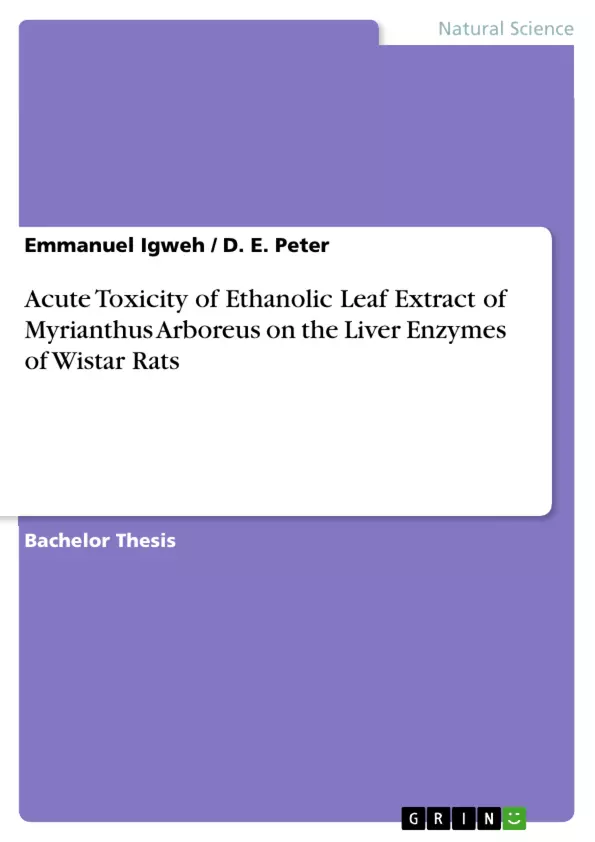The present study was done to evaluate the acute (14 days) toxicity of the ethanolic leaf extract of Myrianthus arboreus on the liver enzymes of wistar rats.
In the acute (14 days) toxicity studies, 24 rats were grouped into 1- 8 groups (n=3rats/cage) and administered with 1500, 1000 and 500 mg/kg body weight for 7 days and 14 days. The rats were sacrificed after 7 days and 14 day of administration and blood samples and liver organ were collected for investigations. The biochemical parameters such as the Alkaline phosphatase (ALP), Alanine transaminase (ALT) and Aspartate aminotransferase (AST) were determined and the liver histology analysed. The mean values of ALP showed significant increase (P≤0.05), the ALT showed a non-significant increase (P≥0.05) at groups 2, 3 and 4 and a significant increase (p≤0.05) at groups 6, 7 and 8. The AST showed a non-significant increase (P≥0.05) at all dosages and times except for group 2. The histological analysis showed microvesicular steatosis at groups 2 and 3 and a ballooning hepatic necrosis at group 7.
The phytochemical analysis of Myrianthus arboreus shows the presence of alkaloids, flavonoids, tannins, anthraquinones, triterpenoids, carbonhydrate, cardenolide and saponins in detectable limits but fixed oils and cyanogenic glycosides were not determined. In this investigation, we can conclude that the ethanolic leaf extract of Myrianthus arboreus was unsafe at all doses considered for a period of 14 days. However, at a dose below 500 mg for 7 days could be considered safe.
Inhaltsverzeichnis (Table of Contents)
- CHAPTER ONE
- 1.0 INTRODUCTION AND LITERATURE REVIEW
- 1.1 PLANT PRODUCTS AS DRUGS.
- 1.2 TOXICITY TESTS
- 1.3 THE USE OF EXPERIMENTAL ANIMAL
- 1.4 THE LIVER
- 1.4.1 STRUCTURE AND FUNCTIONS
- 1.4.2 HEPATOTOXICITY
- 1.4.3 DETOXIFICATION FUNCTION OF THE LIVER
- 1.4.4 MARKER MOLECULES AND LIVER TOXICITY
- 1.5 MYRIANTHUS ARBOREUS, ORIGIN, CLASSIFICATION AND MEDICAL USES.
- 1.6 TAXONOMICAL CLASSIFICATION OF MYRIANTHUS ARBOREUS.
- 1.7 COMPOSITIONS AND PHYTOCHEMISTRY OF MYRIANTHUS ARBOREUS..
- 1.8 AIM AND OBJECTIVES OF THE STUDY
- CHAPTER TWO
- 2.0 MATERIALS AND METHODS
- 2.1 MATERIALS
- 2.1.1 LABORATORY APPARATUS
- 2.1.2 LABORATORY EQUIPMENT..
- 2.1.3 CHEMICAL AND REAGENTS
- 2.1.4 SOURCE OF ANIMAL...
- 2.2 METHODS.
- 2.2.1 COLLECTION AND IDENTIFICATION OF PLANT MATERIALS
- 2.2.2 PREPARATION OF EXTRACT.
- 2.2.3 PHYTOCHEMICAL SCREENING.
- 2.2.4 SELECTION AND SORTING (INTO SIZE AND SEX) OF ANIMALS..
- 2.2.5 RECONSTITUTION OF EXTRACT.
- 2.2.6 LETHAL DOSE (LD50) STUDY OF THE ETHANOLIC LEAF EXTRACTS OF MYRIANTHUS ARBOREUS.
- 12.2.7 EXPERIMENTAL DESIGN
- 2.2.8. SACRIFICE OF THE ANIMALS...
- 2.2.9 BIOCHEMICAL PARAMETERS STUDIES
- 2.2.10 HISTOPATHOLOGICAL STUDIES.
- 2.2.11 STATISTICAL ANALYSIS
- CHAPTER THREE
- 3.1 RESULTS.
- 3.2 RESULTS OF HISTOLOGICAL ANALYSIS
- 3.3 RESULTS OF PHYTOCHEMICAL SCREENING OF THE CRUDE LEAF POWDER OF MYRIANTHUS ARBOREUS (P.BEAUV).
- CHAPTER FOUR
- 4.0 DISCUSSIONS AND CONCLUSIONS.
- 4.1 DISCUSSIONS.
- 4.2 CONCLUSIONS.
- 4.3 LIMITATIONS TO THE STUDY.
- 4.4 SUGGESTIONS FOR FURTHER RESEARCH
- REFERENCE.
- APPENDIX 1
- APPENDIX 2
- LIST OF TABLES
- Table 2.1. Experimental Design
- Table 2.2 Administration of Myrianthus arboreus (MA) Extracts
- Table 3.1 Effects of ethanolic leaf extract of Myrianthus arboreus (MA) on liver enzymes of wistar rats for 7days
- Table 3.2 Effects of ethanolic leaf extract of Myrianthus arboreus (MA) on liver enzymes of wistar rats for 14days
- Table 3.3 Results of Phytochemical Screening
- LIST OF FIGURES
- Figure 1.1 Diagram of a Wistar Rat
- Figure 1.2 Diagram of the liver
- Figure 1.3a Diagram of the Tree of Myrianthus arboreus
- Figure 1.3b Diagram of the leaves of Myrianthus arboreus
Zielsetzung und Themenschwerpunkte (Objectives and Key Themes)
The project investigates the acute toxicity of the ethanolic leaf extract of Myrianthus arboreus on the liver enzymes of Wistar rats. The study aims to evaluate the safety of this extract at different doses and durations of administration.
- The acute toxicity of Myrianthus arboreus extract on the liver of Wistar rats.
- The effects of the extract on specific liver enzymes, including alkaline phosphatase (ALP), alanine transaminase (ALT), and aspartate aminotransferase (AST).
- The impact of the extract on liver histology, including the presence of steatosis and necrosis.
- The phytochemical composition of Myrianthus arboreus and its potential role in liver toxicity.
- The establishment of a safe dosage and administration period for the ethanolic leaf extract of Myrianthus arboreus.
Zusammenfassung der Kapitel (Chapter Summaries)
Chapter 1 provides a comprehensive overview of plant products as drugs, including a discussion on toxicity tests, the use of experimental animals, and a detailed explanation of liver structure, function, and hepatotoxicity. It also presents the botanical classification of Myrianthus arboreus and its known medical uses. Chapter 2 outlines the materials and methods used in the study, including the collection and identification of plant materials, the preparation of the extract, phytochemical screening, experimental design, and the analysis of biochemical and histological data. Chapter 3 presents the results of the study, highlighting the effects of Myrianthus arboreus extract on liver enzymes and liver histology at various doses and time points. Chapter 4 provides a thorough discussion of the findings and conclusions. It explores the potential mechanisms of toxicity, the safety of the extract at different doses and durations, and suggests areas for further research.
Schlüsselwörter (Keywords)
The study focuses on the acute toxicity of Myrianthus arboreus leaf extract on Wistar rats, examining its impact on liver enzymes (ALP, ALT, AST), liver histology (steatosis, necrosis), and the phytochemical composition of the plant. Key concepts include hepatotoxicity, phytochemistry, ethanolic extraction, animal models, and experimental design.
- Quote paper
- Emmanuel Igweh (Author), D. E. Peter (Author), 2015, Acute Toxicity of Ethanolic Leaf Extract of Myrianthus Arboreus on the Liver Enzymes of Wistar Rats, Munich, GRIN Verlag, https://www.grin.com/document/420613



